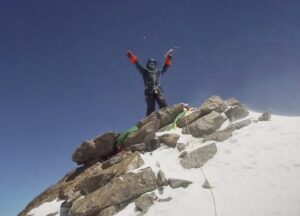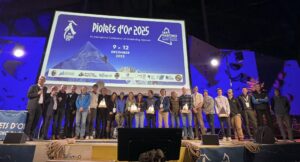There is another Himalaya, silent and wild, close and far at the same time from the cacophony of cell phones, choppers, and big egos crowding the Base Camps of the bigger peaks. A parallel dimension, where adventure, creativity, and risk still dominate. “I wouldn’t think of climbing any other way,” Paul Ramsden told ExplorersWeb.
Ramsden is also one of those climbers flying under the radar, maybe because he has a non-mountaineering job and doesn’t do social media. But he is not under the radar of Piolet d’Or juries. Over 30 Himalayan expeditions, he has won four of the coveted golden ice axes, all with Mick Fowler.

An unlikely line up one of the biggest faces in Nepal. Photo: Paul Ramsden
Where the peaks have no name
This time, Ramsden mentored Tim Miller, a young trainee mountain guide, on an excellent ascent which they researched during the COVID lockdown.
“It was just cruising around on Google Earth during the lockdown;” Ramsden said.
They picked what looked like a really steep face, on a peak that had no name at the time. This spring, with the world open again, they flew to Nepal, obtained a climbing permit, and went to have a look at it.

Tim Miller, left, and Paul Ramsden. Photo: Paul Ramsden
The rarely visited range had one huge granite face that would wow big wall climbers from around the world. “I think it’s one of the biggest, steepest rock walls in Nepal,” said Ramsden. The duo then proceeded to climb it.
The 1,200-1,300m north face showed no weaknesses, except for what looked like a thin, intermittent line of ice.
The hidden crux
“It’s an unlikely line, it shouldn’t really be there on that granite face,” Ramsden told ExplorersWeb.
There was no way to spot a continuous route all up the wall from below, so they just went ahead and trusted themselves to figure out a route as they climbed.
Several times, how to continue was unclear. One spot in particular really looked like a dead end.
“Right in the middle, there was a blank section. We couldn’t figure out how it could be climbed. We thought it would stop us. But when we got there, we discovered there was a chimney up the whole section, which was completely hidden from below. We climbed it in three pitches, completely in the deep chimney. It’s the first time…that I have had such a climb.”

Paul Ramsden on the Phantom Line.
The chimney was not an easy way up. Both the climbing and hauling sacks up such a narrow passage were difficult. “Definitely, that was the crux,” Ramsden said.
The wall had several other hidden sections that forced the climbers up unknown, adventurous terrain. Hence, their name for the route. Ramsden described it as a kind of ghost line. It appeared and disappeared, depending on your angle of view and the light.

Five days on the face
The pair summited on April 29. “It took days to get to the bottom of the route, five days on the face, and one more to make it down,” said Ramsden.
Alpine style at its purest. The new route has 37 pitches and a proposed difficulty of ED. The unnamed peak, 6,563m high, has now been christened Jugal Spire.
While the two men had roped up before, this was their first expedition together. “It’s part of a process of mentoring young people, and we had a really good time.” Already, they have a new objective in mind for next spring.

Tim Miller works his way up the mixed terrain. Photo: Paul Ramsden
Their project had support from the Mount Everest Foundation. “Fortunately, there is a lot of funding in the UK for exploration climbing on small peaks,” Ramsden said. “There is a strong tradition of this kind of exploratory climbing, even if the mainstream public is not that interested.”






